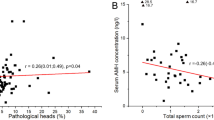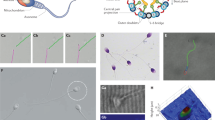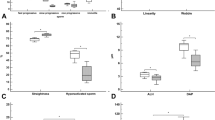Abstract
Williams and Savage1 introduced a semen examination method for the evaluation of the seminal micropathology in bulls, the results of which in the hands of the experienced examiner are of definite value in sterility work, especially in classifying the severity of testis degeneration and testis hypoplasia. Later investigators have used slightly different systems for classifying abnormal sperm forms, but most workers have included abnormalities of the middle piece of the sperm in their counting as rather rare forms2–4.
This is a preview of subscription content, access via your institution
Access options
Subscribe to this journal
Receive 51 print issues and online access
$199.00 per year
only $3.90 per issue
Buy this article
- Purchase on Springer Link
- Instant access to full article PDF
Prices may be subject to local taxes which are calculated during checkout
Similar content being viewed by others
References
Williams, W. W., and Savage, A., Cornell Vet., 15, 353 (1925).
Lagerlöf, N., Acta Path. Microbiol. Scand., Supp., 19 (Uppsala, 1934).
Blom, E., “On the Evaluation of Bull Semen”, Diss. (Copenhagen, 1950).
Bretschneider, L. H., Proc. Kon. Ned. Akad. v. Wetensch., 58/4 (1955).
Blom, E., Fertility and Sterility, 1, 176 (1950).
Author information
Authors and Affiliations
Rights and permissions
About this article
Cite this article
BLOM, E. A Rare Sperm Abnormality: ‘Corkscrew-sperms’ associated with Sterility in Bulls. Nature 183, 1280–1281 (1959). https://doi.org/10.1038/1831280a0
Issue Date:
DOI: https://doi.org/10.1038/1831280a0
This article is cited by
-
Morphologische Studien an abnormen Spermatiden und Spermatozoen des Menschen
Virchows Archiv A Pathological Anatomy and Histology (1975)
-
A New Sterilizing and Hereditary Defect (the ‘Dag Defect’) located in the Bull Sperm Tail
Nature (1966)
Comments
By submitting a comment you agree to abide by our Terms and Community Guidelines. If you find something abusive or that does not comply with our terms or guidelines please flag it as inappropriate.



